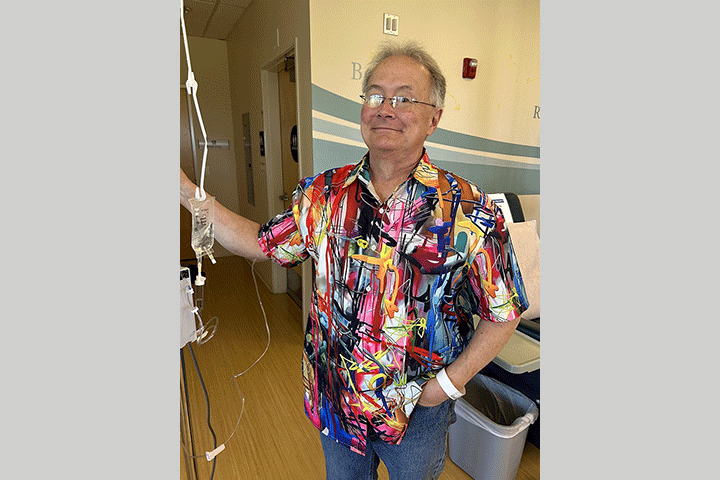Pancreatic Cancer Research Builds Upon Strengths

The 9th annual AACR Special Conference on Pancreatic Cancer, held September 27-30, 2023 in Boston, Massachusetts, has become one of the most popular programs focused on an individual cancer.
This year’s event attracted some 700 attendees, making it the largest meeting to date. In addition, more than 350 abstracts were accepted. The meeting spans basic, translational, and clinical research, and addresses the latest developments in all areas of pancreatic cancer research. The program incorporates numerous talks from submitted abstracts to highlight the advancements and diversity of the pancreatic cancer research field.
This year’s conference showed the depth of pancreatic cancer research. Plenary sessions focused on epidemiology and early detection, diversity and disparities, clinical updates, systems biology, metabolic perturbations, targeted therapies, model systems, and therapeutic opportunities in tumor stromal and immune microenvironments.
Although more work needs to be done in understanding the tumor macro- and microenvironment and in finding more effective therapies, it is this kind of research that will allow for greater improvement in earlier detection and treatment.
As always, Let’s Win will cover some of this research in more depth in upcoming articles. But for now, here is a just a small sample of some of the exciting work presented.
KRAS Inhibition
The KRAS gene, which is altered in more than 90 percent of pancreatic cancers, has long been believed to be undruggable. With many promising new KRAS-targeting therapies either now available or on the horizon, the field may be on the cusp of a revolution in treatment for patients with pancreatic cancer. In anticipation of these drugs becoming available, research is focused on identifying the right environment and right combinations to use these drugs.
- Activating KRAS mutations in pancreatic cancer drives anabolic metabolism and supports tumor maintenance. Anabolic metabolism is the process that supports the growth of new cells, the maintenance of body tissues, and the storage of energy for future use. Researchers found that KRAS inhibitors show initial anti-tumor activity followed by recurrence due to cancer cell-intrinsic and immune-mediated paracrine mechanisms. Paracrine signaling or mechanism is a type of cell signaling process. Researchers then looked at the potential role of cancer-associated fibroblasts (CAFs) in enabling KRAS bypass. They identified CAF-derived NRG1 activation of cancer cell ERBB2 and ERBB3 receptor tyrosine kinases as a mechanism by which KRAS-independent growth is supported. Further research found that CAFs can contribute to KRAS-inhibitor therapy resistance by way of paracrine mechanisms. This finding may provide an actionable treatment strategy to improve KRAS-inhibitor effectiveness.
- The KRAS protein normally acts like an on–off switch. In response to certain signals, it becomes activated and tells the cell to grow and divide. When the signals are no longer present, it turns off. However, some mutant forms of KRAS, such as KRAS G12D, remain active even in the absence of growth signals, leading to uncontrolled cell growth. The KRAS G12D mutation is present in more than one in three pancreatic cancers, about one in ten colorectal cancers, and in several other cancer types. A new candidate drug, known as MRTX1133, shrank tumors or halted growth in tumors with KRAS G12D mutations in mice, including a genetically-engineered mouse model known as KPC, that closely mimics the human disease. In another study published in the journal Cancer Research, investigators found evidence supporting the combination of MRTX1133 with an approved drug, afatinib. The researchers used advanced human patient-derived organoid models as well as in vivo models to show that synergy between afatinib and MRTX1133 results in reduced tumor burden and prolonged survival. They believe the study provides the rationale for testing this drug combination in clinical trials for patients with pancreatic cancer.
- Other researchers are looking at yet another approach to taming KRAS. ELI-002 2P is an investigational therapeutic cancer vaccine targeting solid tumors driven by G12D and G12R mutations in KRAS. As of the April 25, 2023 data cutoff date, among the 22 evaluable patients, preliminary data from the trial suggest that those with greater than median T cell response had not reached median Relapse-Free Survival (RFS) compared to median RFS of 3.91 months for patients with less than median T cell response. Updated data demonstrated 86 percent reduction in risk of progression or death in patients with large T cell responses induced by ELI-002 2P in the phase I study. A randomized phase II study will be initiated in early 2024.
Other Early Trials
- Researchers found that germline BRCA–associated pancreas tumors are susceptible to platinum and PARP inhibition. However, most patients develop resistance. Additional treatment options for this unique subpopulation are needed. The researchers generated model systems that recapitulated these specific clinical scenarios as a platform to investigate the mechanisms of resistance for further drug development. This study presented important data on molecular determinants for this cohort.
- A drug combination called CheMoMETPANC [gemcitabine plus nab-paclitaxel + motixafortide (CXCR4 antagonist) + cemiplimab] showed responses in both primary and metastatic sites, with 64 percent partial responses and 27 percent stable disease. All patients in the trial received paired biopsies for deep correlative studies. This study will now move to a randomized phase II trial.
- Treatment with the novel CD40 monoclonal antibody agonist, mitazalimab, in combination with chemotherapy, achieved deep tumor responses in patients with metastatic pancreatic cancer, according to interim analysis findings from the phase II OPTIMIZE-1 study. The results also established the safety/tolerability profile of the combination. Previously, in 23 patients, 13 had an objective response to mitazalimab in combination with leucovorin calcium (folinic acid), fluorouracil, irinotecan hydrochloride, and oxaliplatin (mFOLFIRINOX). Responses were ongoing in seven patients beyond 10 months. Updated results came from 57 patients after two to 17 months of follow-up. The objective response rate was 44 percent. Responses included stable disease in 33 percent for a disease control rate of 77 percent.
New Technologies
- Spatial transcriptomics is a powerful new approach to characterize the cellular and molecular architecture of the tumor microenvironment. Previous single-cell RNA-sequencing of pancreatic cancer showed a complex immunosuppressive environment. This environment is populated by cancer-associated fibroblasts (CAFs) subtypes that contribute to poor outcomes. Yet, scientists still did not know the evolutionary process behind this biology. Pancreatic intraepithelial neoplasia (PanIN) is a premalignant lesion with potential to develop into pancreatic cancer, but prior technologies fell short in diagnosis of these lesions. Now researchers have developed a new experimental pipeline analysis. They identified a transition between inflammatory signaling induced by CAFs and proliferative signaling in PanIN cells as they become invasive cancers. The integration of imaging, ST, and scRNA-seq data provides an experimental and computational approach for the analysis of cancer development and progression.
- Researchers have developed genetically-engineered mice to carry an enzyme that allows the scientists to change a single base or “letter” in the mouse’s genetic code. The enzyme can be turned on or off. And investigators can also grow miniature versions of intestine, lung, and pancreas tissue called organoids from the mice, enabling even more molecular and biochemical studies of the impact of these precise genetic changes. The mouse model allows them to study the effects of the changes on tumors and determine which therapies work best for those with a particular mutation. Organoids derived from the mice enable detailed experiments in tissues that scientists could not easily target with virus-based approaches. They are currently using this new technology to identify the effects of single-base mutations in lung, colon, and pancreatic cancer. Their genetically-engineered mice will be available to other researchers to use, which may help accelerate progress toward personalized cancer treatment.
Metabolism and Pancreatic Cancer
Pancreatic cancer and metabolism are closely linked. Obesity and diabetes are key environmental risk factors for pancreatic cancer and pancreatic cancer-inducing changes in metabolism that lead to severe cachexia in most patients. Researchers are defining the molecular links between metabolism, tumor formation, and cachexia to identify therapeutic approaches to prevent and treat the disease.
- Pancreatic cancer has the highest rate of cachexia—or severe muscle and fat wasting—of any cancer type, with approximately 80 percent of patients experiencing cachexia. Work has begun to identify the mechanisms from the tumors that drive cachexia. Researchers found that pancreatic tumor cells express high levels of the parathyroid hormone-related protein (PTHrP). This high level of PTHrP appears to be responsible for the cachexia associated with pancreatic cancer. When the researchers blocked the hormone using genetics or an antibody in mice, the mice experienced less weight loss. When weight loss was slowed, the mice survived longer and anti-tumor treatments were more effective. This opens up the possibility of treating cachexia using drugs that block PTHrP.
- Researchers are exploring how diet and obesity are linked to pancreatic cancer risk. By studying mice that are susceptible to obesity, diabetes, and pancreatic cancer they are finding alterations in the hormone-producing cells of the pancreas that drive pancreatic cancer formation. Specifically, in response to obesity, cells in the islets that normally produce insulin begin to produce another hormone, cholecystokinin, that drives cell growth and early tumor formation in the pancreas.
Diversity and Disparities
- While overall cancer incidence and mortality rates are declining across all groups, disparities across the cancer continuum remain a public health challenge. For example, the incidence rate for Black people and African Americans is 20 percent higher and outcomes are less positive than rates among the white population. Yet, pancreatic cancer patients from minority groups continue to be significantly underrepresented in clinical trials, which may obscure disease causes and has the potential to exacerbate disparities in the development of novel therapeutics. Several presentations focused on this issue, including presentations on advancing equity in cancer genetics and prevention, inequities in pancreatic cancer care, and the building of a framework to study pancreatic cancer care in Native American communities.
The full program for this conference is available online. Lead support was provided by the Lustgarten Foundation with additional support from Let’s Win Pancreatic Cancer and Novocure.







